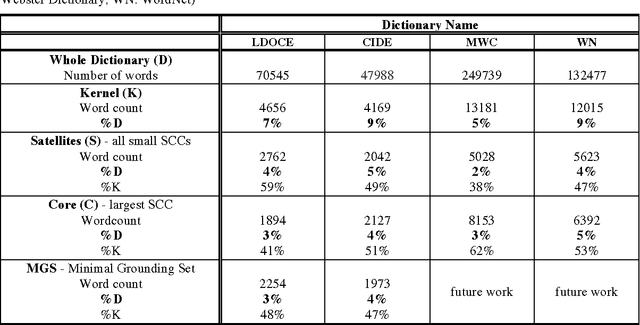Olivier Picard
Hidden Structure and Function in the Lexicon
Sep 16, 2013



Abstract:How many words are needed to define all the words in a dictionary? Graph-theoretic analysis reveals that about 10% of a dictionary is a unique Kernel of words that define one another and all the rest, but this is not the smallest such subset. The Kernel consists of one huge strongly connected component (SCC), about half its size, the Core, surrounded by many small SCCs, the Satellites. Core words can define one another but not the rest of the dictionary. The Kernel also contains many overlapping Minimal Grounding Sets (MGSs), each about the same size as the Core, each part-Core, part-Satellite. MGS words can define all the rest of the dictionary. They are learned earlier, more concrete and more frequent than the rest of the dictionary. Satellite words, not correlated with age or frequency, are less concrete (more abstract) words that are also needed for full lexical power.
* 11 pages, 5 figures, 2 tables
Hierarchies in Dictionary Definition Space
Nov 30, 2009



Abstract:A dictionary defines words in terms of other words. Definitions can tell you the meanings of words you don't know, but only if you know the meanings of the defining words. How many words do you need to know (and which ones) in order to be able to learn all the rest from definitions? We reduced dictionaries to their "grounding kernels" (GKs), about 10% of the dictionary, from which all the other words could be defined. The GK words turned out to have psycholinguistic correlates: they were learned at an earlier age and more concrete than the rest of the dictionary. But one can compress still more: the GK turns out to have internal structure, with a strongly connected "kernel core" (KC) and a surrounding layer, from which a hierarchy of definitional distances can be derived, all the way out to the periphery of the full dictionary. These definitional distances, too, are correlated with psycholinguistic variables (age of acquisition, concreteness, imageability, oral and written frequency) and hence perhaps with the "mental lexicon" in each of our heads.
 Add to Chrome
Add to Chrome Add to Firefox
Add to Firefox Add to Edge
Add to Edge